Behind the Lens – Frank Bell
by Alex W.
Behind the Lens is an ongoing series of articles and interviews exploring the thought process behind successful and excellent photographers. It brings you behind the lens of a particularly excellent image and explains the technical and creative elements that went into creating the photograph.
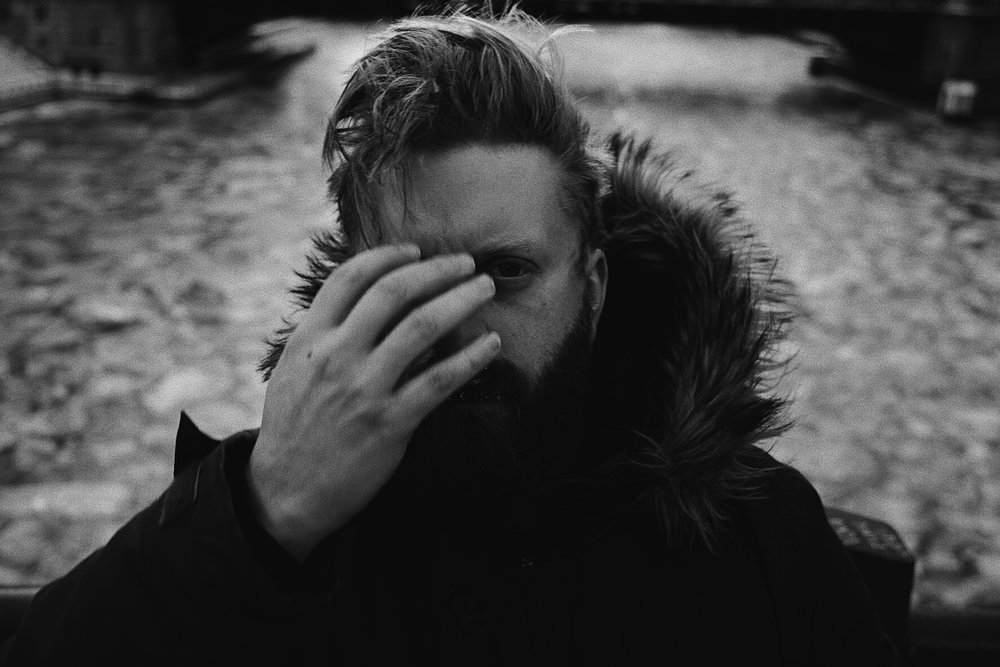
This week on Behind the Lens we meet Frank Bell, a Scottish street photographer now based in Chicago. Frank’s evocative and thought provoking images have attracted high profile clients such as VSCO and Apple, but you can usually find him photographing the shadows of Chicago. This week we look into his perfectly composed street shot from the hustle and bustle of Chicago’s rush hour .
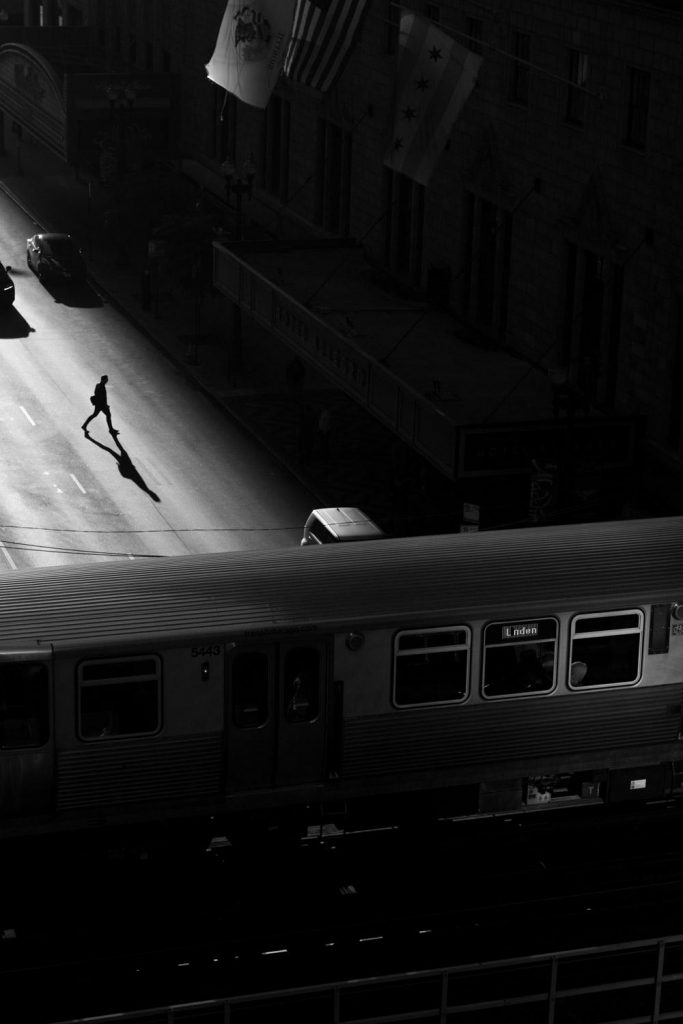
Click and Learn Photography: Hi Frank, first off can you tell us a bit about yourself? How long have you been into photography and what was it that drew you to the art form in the first place?
Frank: I’ve been into photography since around 2003/2004, just as Canon started making consumer DSLRs. I’d used cameras as a kid but it was always just a means to an end, there was never anything creative behind it. But soon after I moved to the US from Edinburgh, Scotland, I got this little 1.3mp camera on eBay and fell in love with it. I wasn’t doing anything great with it, but it removed that cost barrier that exists with shooting film, so I was able to take it everywhere with me.
I think what drew me to photography in the first place was the posterity of it. The ability to see something and keep a visual record of it. I love seeing old photos, especially from the 80s and early 90s that have the time and date stamped on the front. They’re like receipts of extremely specific points in time of someone’s life.
Click and Learn Photography: That’s a really interesting way of looking at it. I like the idea of photographs being receipts of moments in time.
Is that what eventually drew you to street photography? Documenting ordinary moments in an ordinary day of ordinary people, but all in an extraordinary and artistic way?
You Might Like… 5 Places to Start your Street Photography Journey
Frank: I don’t think I’m at the ‘extraordinary’ stage yet, but that’s definitely a goal. I love the banal and mundane details that are a part of everyone’s day and life, but that nobody pays attention to. Like shadows.
What drew me to street photography was actually just the act of moving to Chicago. I’ve never lived in a city this big before, and being able to explore it every day with all the different people and amazing architecture and light. There’s something to see and capture everywhere, so that’s what I did: Explored and shot as much as I could.
Then one day in the middle of summer a couple of years ago I took some photos from the top of a parking garage downtown, looking down onto the street, and everyone had really long shadows and parts of the street were all in darkness. I was hooked fom that day, and as I did it more and more I kept thinking “This is so cool, why don’t people pay more attention to any of it?”
So the shadows/found light aspect of my photography was definitely born out of trying to create something cool with something generally perceived as mundane, and that we all take for granted.
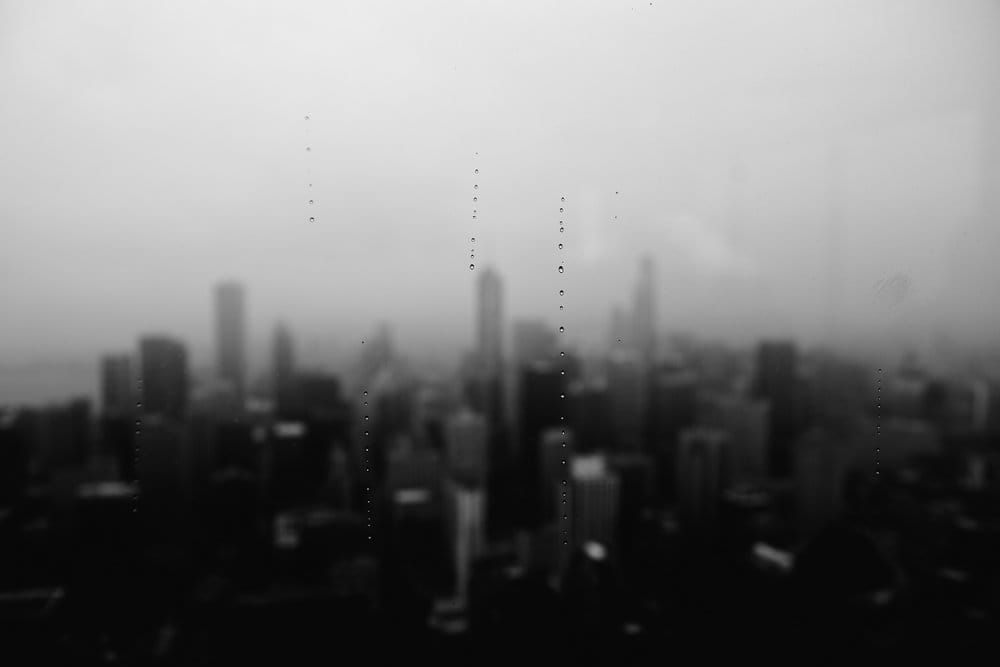
Click and Learn Photography: That’s what I like most about your work, and what drew me to this shot in particular. The contrast between light and shade is so well pronounced and it adds a deep sense of mystery to the image, and in some cases almost a foreboding feeling. It’s starkly different to a lot of the street photography I see and definitely makes your images stand out.
From my limited experience in street photography it’s incredibly difficult to capture those mundane details in an interesting way. How long did it take you to start having some success with your street shots? Was it something you found yourself naturally having an eye for or did it take a lot of failure before you started capturing images such as this?
Frank: ‘Success’ for my found-light photography I’d define as getting to the point where I was consistently really happy with what I was doing, and that probably took until I switched to black and white; maybe a year and a half, around January 2017. That was a year and a half of me shooting thousands of photos every week in my spare time, I was just out with my camera every chance I could.
Until that point I’d been shooting in colour and as I got better at photography my editing didn’t improve that much and I was just getting frustrated too often with how some of my photos were turning out. I tried so many different types and styles before I ended up on black and white, and I spent way too much time trying to follow trends and be like other photographers. I realised I was putting off my own personal growth and improvements just for internet cool points, so I was actively looking to move into something different anyway.
What changed when I switched to black and white was that it removed all the differently coloured distractions and put the focus on the shadows (which is what I’d been trying to do in colour but couldn’t.) In the example above, the neon sign on the train says ‘Linden’ in white surrounded by purple, and it was the first thing you looked at in the colour version. In black and white it makes the person and their shadow draw your eyes first. Once I switched it just fell into place and it slowly started changing the way I saw light and shadows, and eventually how I shot.
So many ‘failures’, but you need that to grow and learn and figure out what gets you excited, you know?
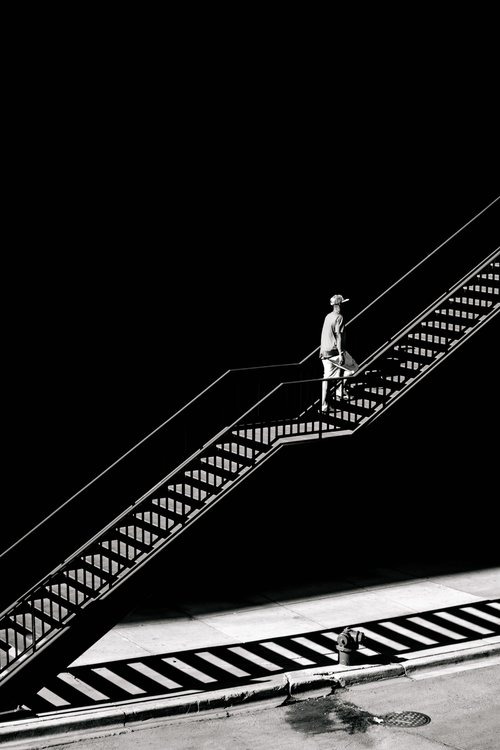
Click and Learn Photography: I think all types of photographers have trouble trying to define their own style, but once they finally do break the mould and stop relying on internet trends you can really see a dramatic improvement in their work. There’s a great quote from Henri Cartier-Bresson on the subject of failure and growth that I really like to refer back to – “Your first 10,000 photographs are your worst.”
The switch to black and white is something you see a lot of in street photography, but it seems like most do it just because it’s what everybody else does rather than thinking about what the actual reasons are behind it. You seem to have the right approach though, and it’s something that comes across in your editing too with the huge contrast and deep blacks. What programs and techniques do you use for your post processing? Is there anything advanced or is it just the usual edits taken a step further?
You Might Like… Using Leading Lines to Improve Your Composition
Frank: When I shoot I almost always underexpose. For one, it makes the shadows even deeper and darker without having to rely too much on post-processing, and two, it means not blowing out the highlights to the point where their detail is irrecoverable. Both of those add to the high contrast look in a lot of my photos, even though I don’t actually use the contrast slider when I edit.
I use Lightroom on my computer to organise and edit, and VSCO on my iPhone. When I first moved to Chicago I’d get on the train home and copy the photos from my camera to my phone and just edit them in VSCO on the ride back, and I was doing that for about 9 months. Then I got Lightroom for my PC and I’ve slowly just been teaching myself over the last two and a half years or so. At first I would use VSCO presets and change their settings around a bit, and then from that I ended up having dozens of my own different presets, and I was using and refining those up until I switched to black and white last January. Some of the photos from those early preset days are awful looking back haha.
Now in black and white, I don’t use presets at all and barely do much editing either. Each photo I edit I just convert to black and white, adjust the exposure, highlights, whites, shadows, and blacks as needed, crop it, do some spot removal on little distractions, and that’s honestly about it. A lot of the time I don’t even do that much, which is one of the beauties of editing in black and white.
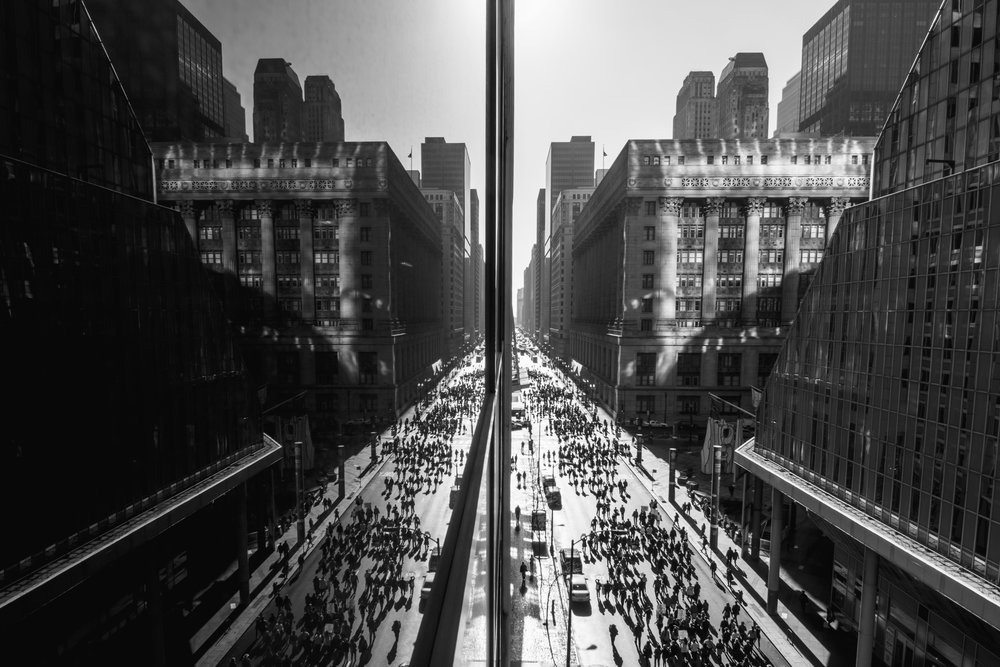
Click and Learn Photography: I can see why, it’s definitely a more rewarding process to get it right in camera and it cuts down on the dreaded PC time too!
Now that you’ve finally found ‘your style’ do you have any plans for the future in regards to photography? Perhaps any dream locations you’d like to visit or some other techniques or genres that interest you? Have you ever considered going back to shoot Edinburgh? Having visited before I can definitely see the photographic potential there.
Frank: I definitely plan on shooting in Edinburgh again. I’ve shot a bit when I’ve been back to visit, but since I got into photography I’ve never been able to spend just days and days walking around shooting there. Looking back, before I moved to the U.S. I definitely took Edinburgh’s beauty and history and culture for granted. I guess I thought I’d live there a lot longer than I did, and when you’re surrounded by these things every day, they just blend into the background. Especially when you’re 20 and all you really care about is football, music, and girls. So now when I’m back I see things through the lens of what would make a good photo, and Edinburgh has so many levels to it, like in the Old Town, that makes the light so unique I could spend hours just on a few streets.
My plans for the future are to break out of this style and try something new. I have loads of ideas and I’m slowly getting to the point where I’m starting to execute some of them, so I’ll probably do more concept shoots, portraits, album covers. I’m definitely getting into shooting video this year, and I’m working on recreating my shadow portraits with artificial light so it can be mobile and I can do those when there’s no sun. I’m also hoping to open a studio in my neighbourhood in Chicago (Old Irving Park), and I’ve been setting up a series of pop-up art shows for local artists in empty storefronts in Irving Park, so those are probably the biggest things I’m working on this year.
There are so many places that I want to visit and shoot. Marrakech, Oslo, Tokyo, St Petersburg, Rio De Janeiro, Singapore, Seoul, New Zealand in its entirety. My girlfriend and I are taking a trip out to L.A. and Joshua Tree in May and I’m excited for the abundance of sun, but I’m looking forward to playing with the light out there. It’s another place I haven’t visited since I started photography.
Click and Learn Photography: That’s the beauty of photography – It definitely makes you sit up and take notice of the culture and history of everything around you. The exact same thing happened to me and the area I live when I first started in photography.
Your plans sound pretty well thought out. Do you have any work from this new style that’s ready to share, and what is it you’re planning on working on in the studio? From the sounds of it you’re going to be very busy, so hopefully you get some time to fit all that travelling in!
Frank: I have a few ideas for concept shoots in the studio, but I have to build a couple of things first. I also want to try turning it into some kind of interactive shadow/light solo show, but I need to write it down and flesh that out because it mostly lives in my head at the moment. Other than that, the work I want to do in there for now is just practise shooting with artificial light and getting better at that so that I can produce more studio based work, especially since I’d like to make my shadow portraits mobile.
I’ve shared some of my ‘new style’ on Twitter (@12headedboy) but it’s more just me playing around with shooting models and editing in colour for now. When I have something I feel better about I’ll probably share it with a wider audience, but most of it I’m just holding onto for now.
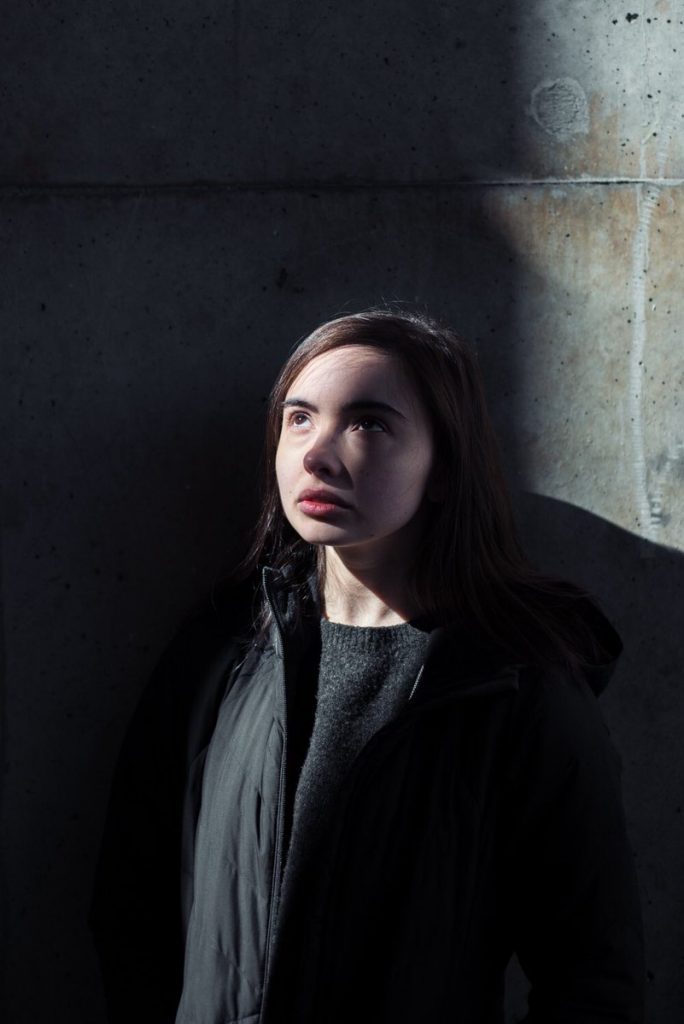
Click and Learn Photography: That sounds really interesting, I look forward to keeping an eye on it! Your ideas with shadows definitely have potential for some interesting projects, and you can see it’s still a massive part of your work even in these new styles. Your colour work is actually really interesting; it’s very muted, so it retains that realism without letting the colour overpower the image and take away from the composition and tonality.
I look forward to seeing all your plans come together in the future. Thanks for chatting to us Frank!
Frank Bell is a street photographer originally from Scotland, now operating out of Chicago. He has a passion for light and shade, and his mysterious street images have attracted the interest of brands such as VSCO and Apple. He is also the man behind Unrecordedmu.com and curates pop-up art galleries in his Chicago neighbourhood. Click below to see more of his work.
Read More…
5 Places to Start your Street Photography Journey
Beginners Guide to Composition
 |
 |
 |
 |

About Alex W.
Alex is the owner and lead writer for Click and Learn Photography. An avid landscape, equine, and pet photographer living and working in the beautiful Lake District, UK, Alex has had his work featured in a number of high profile publications, including the Take a View Landscape Photographer of the Year, Outdoor Photographer of the Year, and Amateur Photographer Magazine.
Thoughts on "Behind the Lens – Frank Bell"
 |
 |
 |
 |
You can Get FREE Gifts. Furthermore, Free Items here. Disable Ad Blocker to receive them all.
Once done, hit anything below
 |
 |
 |
 |